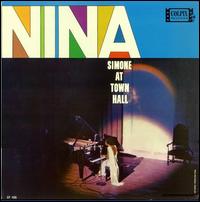
Nina Simone was an American singer, songwriter, pianist, composer, arranger and civil rights activist. Her music spanned styles including classical, folk, gospel, blues, jazz, R&B, and pop. In 2023 Rolling Stone ranked Simone at No. 21 on their list of the 200 Greatest Singers of All Time.
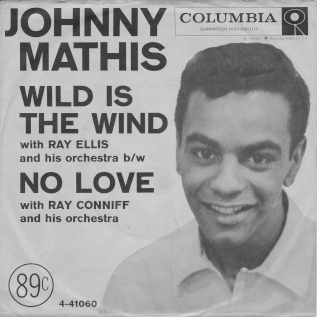
"Wild Is the Wind" is a song written by Dimitri Tiomkin and Ned Washington for the 1957 film Wild Is the Wind. Johnny Mathis recorded the song for the film and released it as a single in November 1957. Mathis' version reached No. 22 on the Billboard chart. It was nominated for an Academy Award for Best Song in 1958, but lost to "All the Way" by Jimmy Van Heusen and Sammy Cahn from The Joker is Wild.

Wild Is the Wind is the sixth studio album by American singer and pianist Nina Simone released by Philips Records in 1966. The album was compiled from several recordings that were left over from sessions for previous Philips albums.

"Sinner Man" or "Sinnerman" is an African American traditional spiritual song that has been recorded by a number of performers and has been incorporated in many other media and arts. The lyrics describe a sinner attempting to hide from divine justice on Judgment Day. It was recorded in the 1950s by Les Baxter, the Swan Silvertones, the Weavers and others, before Nina Simone recorded an extended version in 1965.
Colpix Records was the first recording company for Columbia Pictures–Screen Gems. Colpix got its name from combining Columbia (Col) and Pictures (Pix). CBS, which owned Columbia Records, then sued Columbia Pictures for trademark infringement over the Colpix name.
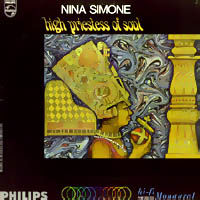
High Priestess of Soul is a studio album by jazz singer, pianist and songwriter Nina Simone. The songs are accompanied by a large band directed and arranged by Hal Mooney. The album contains pop songs and African American gospel and folk related songs written by Simone herself. After this album title –an attempt to broaden her appeal by management execs– Nina Simone was sometimes titled “the high priestess of soul”, although she completely rejected the title herself because it placed a label on her as an artist. However, according to her daughter, Lisa, she never hated that moniker.

Let It All Out is an album by Nina Simone, released by Philips Records in February 1966.
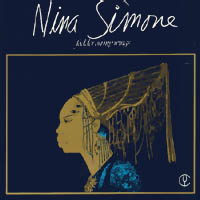
Fodder on My Wings is an album by singer/pianist/songwriter Nina Simone. It is part of her later works, and can be regarded alongside Baltimore (1978) as one of her better achievements of that period. It is however a rather obscure album and not widely distributed. The album is one of Simone's most introspective and personal works, with songs about her father's death and her stay in Liberia, Trinidad, and Switzerland. There is some confusion about the actual title of the album and the song with almost the same title on the album, being called "Fodder on My Wings", "Fodder in My Wings", "Fodder in Her Wings" interchangeably. In 2015, the album was reissued on CD in the US by Sunnyside. In April 2020 the album was reissued on vinyl, CD and digital format with an alternative track-listing and new album artwork.

Baltimore is the fourteenth studio album by American singer-songwriter and pianist Nina Simone, released in January 1978 by CTI Records. Due to a lack of promotion, and Simone's dissatisfaction with the record, It became a commercial failure, failed to chart, and also received mixed reviews from critics. It would also become her first and only album released under her contract with CTI Records. The title track was originally written and recorded by Randy Newman in 1977.

Sings the Blues is an album by singer/pianist/songwriter Nina Simone. This was Simone's first album for RCA Records after previously recording for Colpix Records and Philips Records. The album was also reissued in 2006 with bonus tracks, and re-packaged in 1991 by RCA/Novus as a 17-track compilation under the title The Blues.
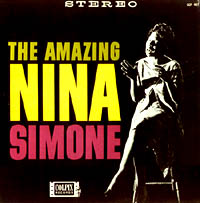
The Amazing Nina Simone is the second studio album by Nina Simone, released in July 1959. It was her second album, and her first recording for Colpix Records. The album contains a variety of material, including jazz, gospel, and folk songs. Compared to her debut, which showcased Simone's piano playing ability in addition to her singing, the piano was downplayed on Amazing in favor of string arrangements.

Nina's Choice is an album by singer/pianist/songwriter Nina Simone. It is a compilation of singles from previous albums at Colpix Records hand-picked by Simone.

Nina Simone at Newport is a live album by jazz singer and musician Nina Simone. It was released in August 1960; the recording taken from a concert held at the Newport Jazz Festival earlier in the year, on 30 June 1960. The album was her fourth overall, and her third for Colpix; it was also her second live album, following on from Nina Simone at Town Hall (1959) released at the end of the previous year. All arrangements on Nina Simone at Newport were written by Simone, and it was produced by Stu Phillips.

Forbidden Fruit is the third studio album by Nina Simone. It was her second studio album for Colpix. The rhythm section accompanying her is the same trio as on both live albums before and after this release.

Nina Simone at the Village Gate is a live album by singer / pianist / songwriter Nina Simone. Released in early 1962, it was her third live album for Colpix. The album was recorded at The Village Gate, a nightclub in Greenwich Village, New York in late March 1961, nearly a year before it saw release. The original release featured eight of the twelve songs performed at the gig. In 2005, an extended version of the album was released with the four remaining tracks.

Little Girl Blue: Jazz as Played in an Exclusive Side Street Club is the debut studio album by Nina Simone. Recorded in late 1957, it was eventually released by Bethlehem Records in February 1959. Due to the length of time the album had taken to be released and the lack of any promotional single either immediately before or alongside the album, Simone would become disillusioned with Bethlehem and sign with Colpix Records in April 1959. She recorded the tracks for her second album - what would become The Amazing Nina Simone - the same month. However, in May Bethlehem finally released a single, "I Loves You, Porgy" and gave Simone her first hit later that year, peaking at number 18 on the pop charts, and number 2 on the R&B charts. Helped by the profile of the single, the album too went on to become a chart success.
"My Man's Gone Now" is an aria composed by George Gershwin, with lyrics by DuBose Heyward, written for the opera Porgy and Bess (1935).
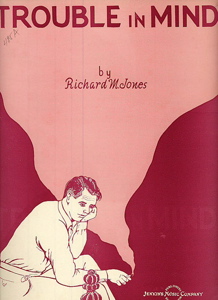
"Trouble in Mind" is a vaudeville blues-style song written by jazz pianist Richard M. Jones. Singer Thelma La Vizzo with Jones on piano first recorded it in 1924 and in 1926, Bertha "Chippie" Hill popularized the tune with her recording with Jones and trumpeter Louis Armstrong. The song became an early blues standard, with numerous renditions by a variety of musicians in a variety of styles.

Nina Simone was an American singer, songwriter, pianist, and arranger.
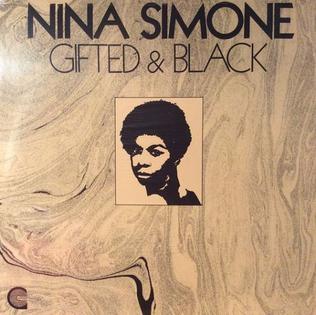
Gifted & Black is an unofficial studio album from jazz singer, pianist, and songwriter Nina Simone. It was originally released in 1970 by Canyon Records. However, it is thought to be a demo tape made by Simone in the spring of 1957 some months before the recording of Little Girl Blue, her first official album, in December of the same year. For the release in 1970, the original recording had strings added.
